

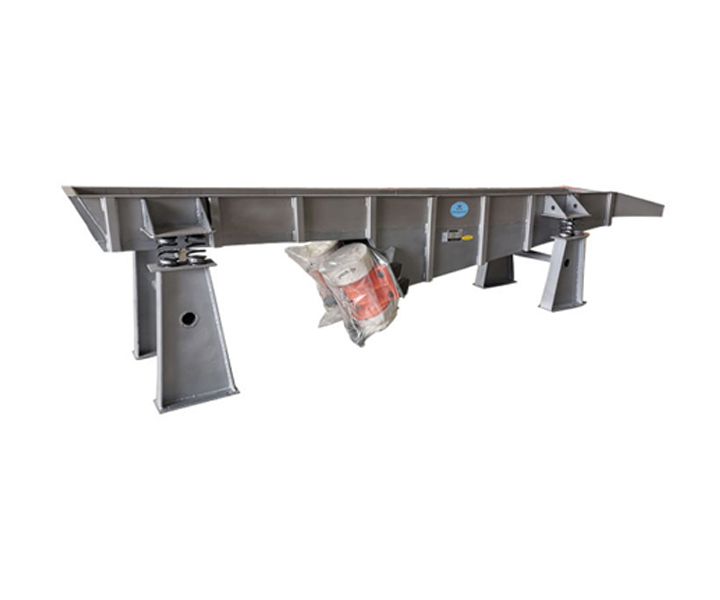
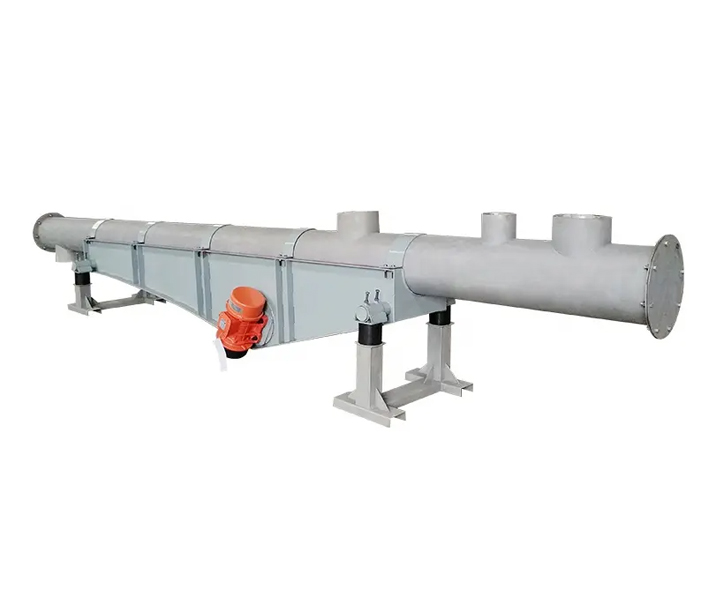
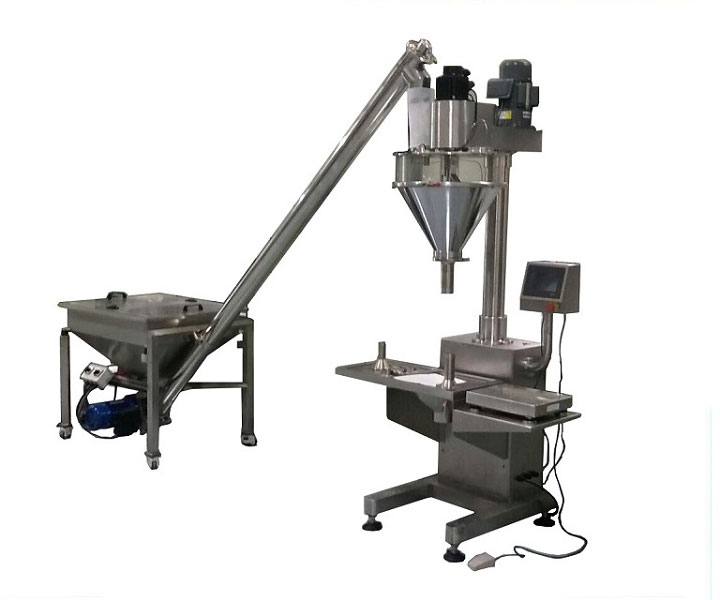





The material is conveyed by the reciprocating vibration of the conveying trough, mainly used for conveying equipment for bulk material conveying and batching
![]()
![]()
Price:$700.00-$5,000.00/Set
Consult now and enjoy a 10% discount
Type: Tubular or Slotted
Feeding granularity: 30-100mm
Conveying length: ≤10 meters
Delivery capacity: 10-35 tons/hour
Power: 2×0.4 kw
Customization: open or closed conveying, can be made into one-point feeding, one-point discharging, one-point feeding, multi-point discharging, multi-point feeding, one-point discharging and other types according to needs
Application: It can uniformly and continuously send various lumpy, granular and powdery materials from the storage bin or hopper into the receiving device.
Commitment:
A vibrating conveyor is a type of mechanical conveying system that uses vibrations to move materials along a trough or conveyor pan. Vibrating conveyors are commonly used in industrial settings to transport bulk materials such as powders, granules, or pellets. They are particularly useful for handling materials that are fragile or prone to breakage, as the gentle vibrations prevent excessive impact or compression.
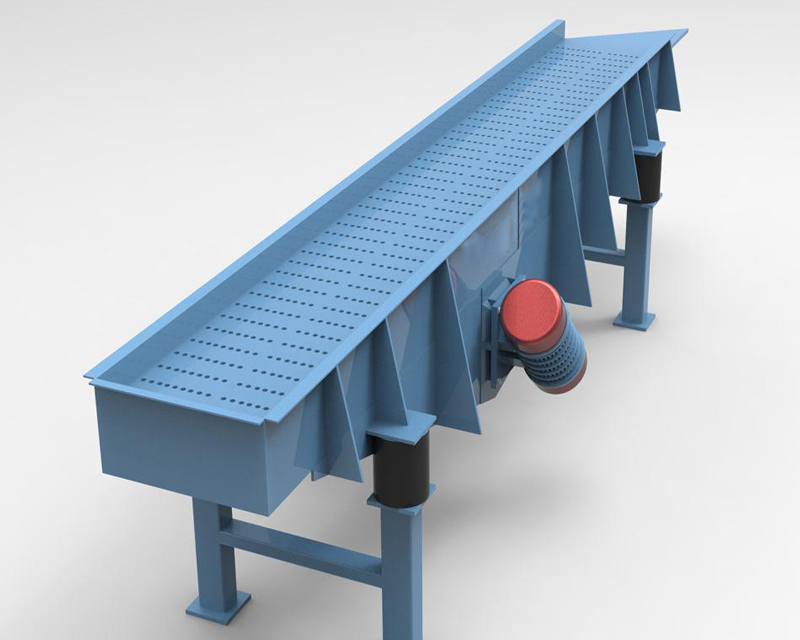
Vibrating conveyors can be customized to fit specific applications, with options for trough size, material type, and vibration frequency. They are versatile and energy-efficient, and require less maintenance than other types of conveyors. They are also a low-noise option for applications where noise levels need to be kept low.
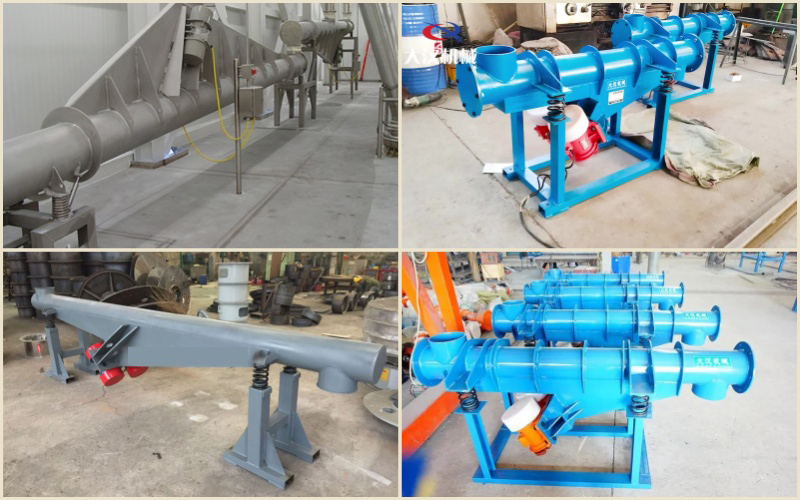
The vibrating conveyor uses the vibration of the trough to quickly transport the material in the trough from the inlet to the outlet. It can be used to convey various materials in the form of lumps, granules or powders, at room temperature or high temperature. In addition, materials can also be screened, dehydrated, cooled or dried during the transportation process.
Common features include:
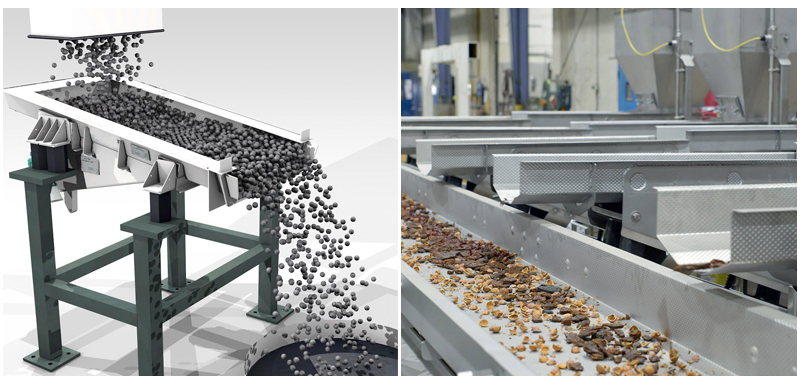
1. Feed: Feed material into processing equipment such as mixers, dryers or packaging machines.
2. Sorting and separating materials: It can be used to sort and separate materials by size or weight. Vibrating motion can help separate stuck-together materials or remove debris or foreign matter.
3. Unloading: used for unloading from the hopper or storage bin. Vibrating motion helps ensure all material is expelled from the container.
4. Conveying materials: Conveying materials from one location to another, such as moving materials from a processing stage to a storage area.
| Types | Trough Vibrating Conveyor | Tube Vibrating Conveyor | Electromagnetic Vibrating Conveyor | Spiral Vibrating Conveyor |
| Image | 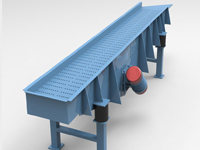 |
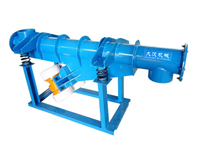 |
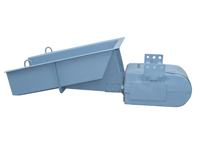 |
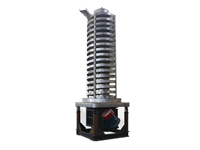 |
| Features | The material is conveyed by the reciprocating vibration of the conveying trough, and the installation position of the motor can be on the upper side, the lower side or both sides. Available in open or closed design. | The powder and granular materials are conveyed horizontally at a controlled rate in a closed circular pipe, and several conveying pipes can be connected to convey synchronously. Closed design, not easy to raise dust | Vibration is generated by an electromagnetic drive system, which is composed of coils and magnets, used to generate a magnetic field to make the tank vibrate. | The material is conveyed vertically in a circular motion using a spiral groove. |
| Application | It is used to convey various materials in block, granular or powder form, at room temperature or high temperature. | It is used for feeding operations of powdery, granular and block materials. | Often used to convey smaller, lighter materials. | For conveying materials that are difficult for other types of conveyors, such as sticky or sticky materials. |
| Delivery volume | 4-23t/h | 15-55t/h | 10-20t/h | 4t/h |
| Delivery length | 20 meters | 30 meters | 2-12 meters | 6 meters (vertical conveying height) |
The vibrating conveyor uses two vibration motors as the excitation source. Using the principle of self-synchronization, when the vibration motors rotate in the opposite direction for two days, the balance frame at the bottom of the conveyor reciprocates, and the upper conveying is driven by the action of the main vibration spring and the guide leaf spring. The tank vibrates to realize the conveying of materials.
Gentle Handling
Operate with a gentle, low-impact motion that is ideal for handling fragile or delicate materials that might be damaged by other types of conveyors. The vibration helps to prevent sticking, clumping, or other types of material buildup that can occur with other conveyors.
Versatility
Vibrating conveyors can be used to move a wide range of materials, including powders, granules, pellets, and even irregularly shaped materials. They can also be customized to fit specific applications, with options for trough size, material type, and vibration frequency.
Energy Efficiency
Vibrating conveyors require less energy to operate than other types of conveyors, making them a more energy-efficient option. This is because the vibration motion used to move materials requires less force than other types of mechanical motion.
Low Maintenance
Are relatively simple to operate and require less maintenance than other types of conveyors. They have fewer moving parts, which means there are fewer components that can break down or require replacement.
Noise Reduction
The conveyor has two speeds, fast and slow, to adapt to different requirements for bulk transportation and packaging, which improves the utilization of equipment and gives full play to the multi-purpose performance of one machine.
Precise control
The vibrating conveyor can accurately control the conveying speed and amount of materials to ensure the accuracy of the production process.
| model | Delivery capacity (t/h) |
conveying distance (m) |
conveying particles (mm) |
double amplitude (mm) |
frequency (Next / min) |
power (kw) |
current (A) |
foundation vertical dynamic load (N) |
weight (kg) |
|
| ZPS-3 | Ⅰ | 11 | 3 | 30 | 4-6 | 1450 | 0.75×2 | 1.84×2 | 1570 | 308 |
| Ⅱ | 17 | 60 | 2140 | 420 | ||||||
| Ⅲ | 25 | 100 | 2300 | 450 | ||||||
| ZPS-4 | Ⅰ | 11 | 4 | 30 | 4-6 | 1450 | 0.75×2 | 1.84×2 | 2650 | 520 |
| Ⅱ | 17 | 60 | 2960 | 580 | ||||||
| Ⅲ | 25 | 100 | 3160 | 620 | ||||||
| ZPS-5 | Ⅰ | 9 | 5 | 30 | 4-6 | 1450 | 1.5×2 | 3.84×2 | 3320 | 650 |
| Ⅱ | 15 | 60 | 3520 | 690 | ||||||
| Ⅲ | 23 | 100 | 3670 | 720 | ||||||
| ZPS-6 | Ⅰ | 9 | 6 | 30 | 5-7 | 960 | 2×2 | 4.1×2 | 4030 | 790 |
| Ⅱ | 13 | 60 | 4390 | 860 | ||||||
| Ⅲ | 23 | 100 | 5610 | 1100 | ||||||
| ZPS-7 | Ⅰ | 9 | 7 | 30 | 5-7 | 960 | 2×2 | 4.1×2 | 6120 | 1200 |
| Ⅱ | 13 | 60 | 6890 | 1350 | ||||||
| Ⅲ | 20 | 100 | 7190 | 1410 | ||||||
| ZPS-8 | Ⅰ | 7 | 8 | 30 | 5-7 | 960 | 2.5×2 | 5.75×2 | 8160 | 1600 |
| Ⅱ | 12 | 60 | 8780 | 1720 | ||||||
| Ⅲ | 8 | 100 | 9340 | 1850 | ||||||
| ZPS-9 | Ⅰ | 5 | 9 | 30 | 6-8 | 960 | 3.7×2 | 7.4×2 | 10710 | 2100 |
| Ⅱ | 10 | 60 | 11480 | 2250 | ||||||
| Ⅲ | 15 | 100 | 12250 | 2400 | ||||||
| ZPS-10 | Ⅰ | 5 | 10 | 30 | 6-8 | 960 | 3.7×2 | 7.4×2 | 12760 | 2500 |
| Ⅱ | 10 | 60 | 13520 | 2650 | ||||||
| Ⅲ | 15 | 100 | 14290 | 2800 | ||||||
| ZPS-12 | Ⅰ | 4 | 12 | 30 | 6-8 | 960 | 3.7×2 | 7.4×2 | 13830 | 2800 |
| Ⅱ | 8 | 60 | 14800 | 2900 | ||||||
| Ⅲ | 12 | 100 | 15870 | 3110 | ||||||
ZPS series motor vibrating conveyor can be made according to user needs:
Bottom vibration type (X): The vibration motor is placed under the conveyor;
Upper vibration type (S): The vibration motor is placed on the top of the feeder;
Speed regulation type (T): The vibration frequency of the vibration motor can be adjusted steplessly within the range of 0-rated frequency;
Open type (K): The top of the conveyor is open, which is more suitable for the downward vibration type;
Sealed type (F): The conveyor is completely sealed except for the inlet and outlet;
Pedestal type (Z): For large (heavy) conveyors, a pedestal structure is generally used.

Vibrating conveyors have a wide range of applications in various industrial fields:
Food processing industry: often used in food transportation, sorting, screening and other processes. For example, it is used to transport vegetables, fruits, candies, nuts, cereals and other food raw materials or finished products.
Chemical industry: In chemical production, it can be used to transport chemical raw materials, granular products, powders and other materials, such as fertilizers, plastic particles, chemical additives, etc.
Mining Industry: In the mining and mining industry, vibrating conveyors are often used to transport raw materials such as ore, coal, sand and gravel.
Building materials industry: In building materials production, vibrating conveyors can be used to transport raw materials such as cement, mortar, sand and gravel.
Metallurgical industry: In metallurgical production, vibrating conveyors can be used to transport metal ores, smelting raw materials, etc.
Pharmaceutical industry: In pharmaceutical production, vibrating conveyors are often used to transport pharmaceutical raw materials such as medicinal materials, medicinal powders, and tablets.

The basic structure of the vibrating conveyor: vibrator, conveying trough (feeding pipe, carrier, tank body) and balance chassis (underframe), main vibration spring and vibration isolation spring, feeding device and unloading device.
1. Vibrator: The exciting force used to generate periodic changes is the power source to maintain the reciprocating motion of the vibrating conveyor. The size of the exciting force directly affects the amplitude of the conveying trough. According to different principles, it can be divided into motor type and electromagnetic type.
2. Conveying trough (feeding pipe, carrier, tank body) and balanced chassis (underframe): they are two vibrating bodies in the vibration system. The conveying trough carries materials and performs reciprocating motion to convey materials. To balance the inertial force of the tank, reduce the dynamic load on the foundation, etc.
3. Main vibration spring and vibration isolation spring: The main vibration spring and vibration isolation spring are the elastic components of the vibration system. Elastic elements sometimes also include link springs that transmit the exciting force. The function of the main vibration spring (resonance spring or energy storage spring) is to make the vibrating conveyor have a suitable near-resonant operating point (ie, frequency ratio), so that the kinetic energy and potential energy of the system vibration can be transformed into each other; the function of the vibration isolation spring is to support The vibration mechanism reduces the dynamic load transmitted to the foundation by the system, etc.
4. Feeding device and unloading device: It is used to control the feeding and discharging of the conveyor, and it is generally connected to the fixed part of the equipment by means of a soft connection.
The customization options for vibrating conveyors allow them to be tailored to specific applications, ensuring optimal performance and efficiency. The ability to customize the design of the conveyor makes it a versatile and flexible solution for a wide range of industrial settings.
1. Trough Size: The size of the trough can be customized to fit the dimensions of the materials being transported. A larger trough can be used to transport larger volumes of materials, while a smaller trough can be used for more precise handling.
2. Material Type: The type of material used for the trough can be customized to fit the requirements of the application. Different materials may be used depending on the temperature, abrasiveness, or chemical composition of the materials being transported.
3. Vibration Frequency: The vibration frequency of the conveyor can be adjusted to fit the requirements of the application. Higher frequencies may be used for faster transport, while lower frequencies may be used for more precise handling.
4. Spring System: The spring system used to support the trough can be customized to fit the weight and stiffness of the materials being transported. A stiffer spring system may be used for heavier materials, while a more flexible system may be used for lighter materials.
5. Drive System: The drive system used to generate vibration can be customized to fit the requirements of the application. Different types of drive systems may be used depending on the power source available, the desired vibration frequency, or other factors.
6. Controls: The controls for the conveyor can be customized to fit the requirements of the application. Different types of controls may be used depending on the level of automation required, such as manual controls, programmable logic controllers (PLCs), or computerized systems.
7. Accessories: Various accessories can be added to the vibrating conveyor to enhance its functionality and performance. For example, side walls or covers can be added to contain the materials being transported, while discharge gates or chutes can be added to control the flow of materials.

| Comparison item | Belt conveyors | Vibrating Conveyor |
| Delivery method | Use flat belts or a series of rollers to move material along a fixed path. Belts or pulleys are driven by motors, which move the conveyor belt. | Vibration is used to move material along a trough or conveyor pan. The trough is mounted on a spring system and driven by an electric motor that causes the trough to vibrate. |
| Application | Belt conveyors sometimes damage or deform fragile materials due to the pressure or force of the belt or rollers | Uses gentle vibrations to move material, making it a better choice for handling fragile or breakable materials. |
| How to choose | Typically used for longer distances and heavier materials | Better suited for shorter distances and lighter materials. |

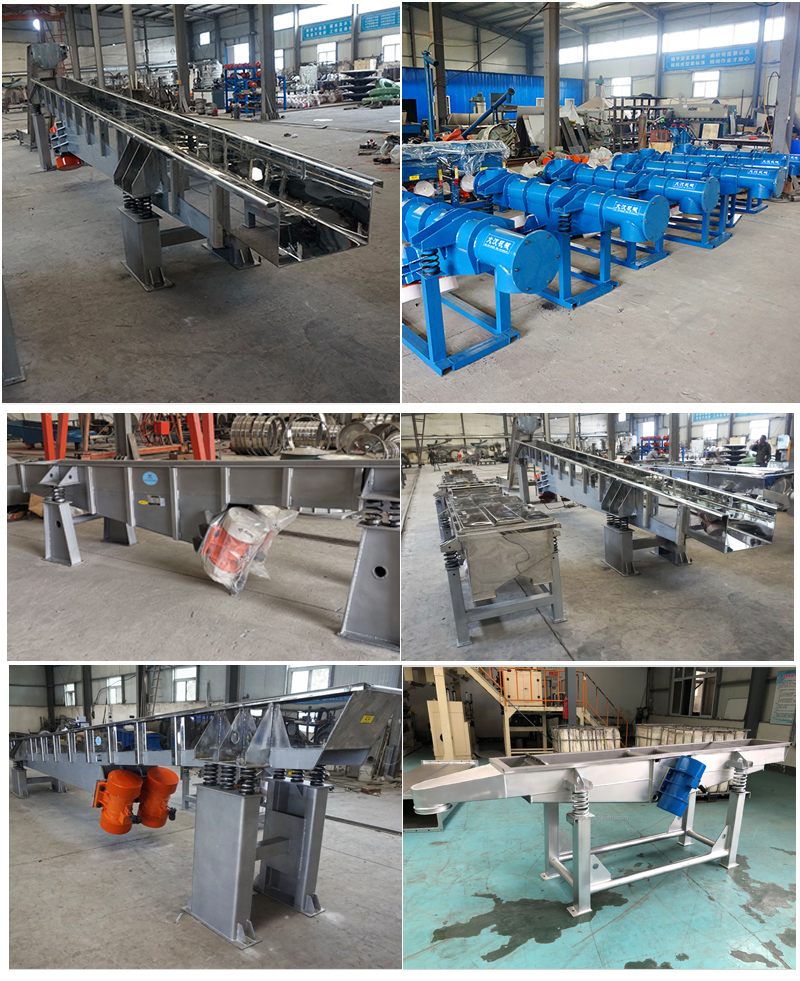
Address:China,Yanjin county forest park gate to the west 1000 meters north road.